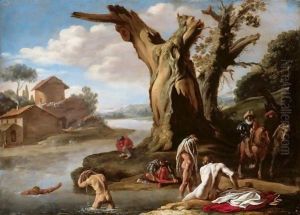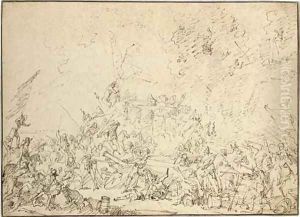Filippo (Il Napoletano) D'Angeli Paintings
Filippo D'Angeli, known as Il Napoletano ('The Neapolitan'), was an Italian painter born in 1585 in Naples, Italy. His artistic journey began in his hometown, but he is most renowned for his work and life in Rome, where he moved to further his career. D'Angeli's early life in Naples, a city with a vibrant artistic scene, provided him with a solid foundation in the arts, deeply influencing his stylistic development. However, detailed records of his early training are scarce, and much of what is known about his formative years is pieced together from his later works and the influences evident in them.
D'Angeli's move to Rome marked the beginning of a significant phase in his career. Rome, the epicenter of Baroque art, offered him exposure to the works of contemporaries and masters such as Caravaggio, whose dramatic use of light and shadow had a profound impact on D'Angeli's style. In Rome, he became known for his small-scale historical and biblical scenes, characterized by their intricate detail, vibrant colors, and the dramatic interplay of light and shadow, reflecting the Caravaggesque influence.
Despite being known as 'The Neapolitan,' D'Angeli's work was very much a product of the Roman artistic environment. His paintings were sought after by collectors and connoisseurs for their beauty and emotional depth. He was adept at conveying complex narratives through his paintings, a skill that earned him commissions from prominent patrons. However, unlike many of his contemporaries, D'Angeli did not leave behind a large body of work, and some of his pieces have been lost or attributed to other artists over the centuries, making a comprehensive assessment of his oeuvre challenging.
Filippo D'Angeli died in 1640 in Rome. His death marked the loss of a talented artist who had contributed to the richness of Baroque painting. Though not as widely recognized as some of his contemporaries, D'Angeli's work continues to be appreciated by art historians and collectors for its beauty and the glimpse it offers into the Baroque period's artistic innovations. His legacy, while modest in volume, is significant for its contribution to the depth and diversity of Italian Baroque art.


